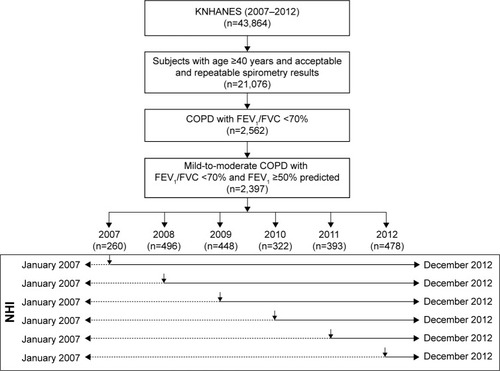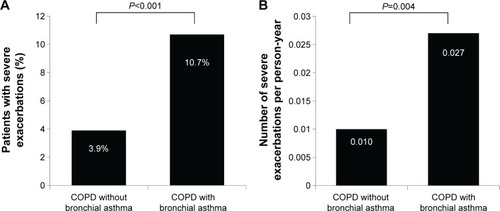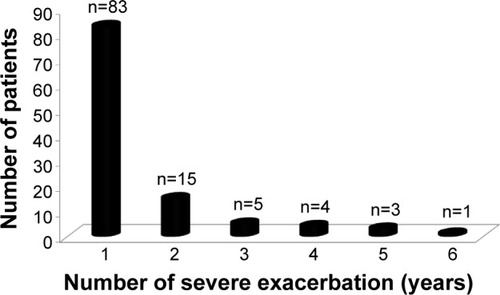Figures & data
Figure 1 Study flow chart and outcome assessment flow using KNHANES and NHI reimbursement database.
Abbreviations: FEV1, forced expiratory volume in 1 second; FVC, forced vital capacity; KNHANES, Korean National Health and Nutrition Examination Survey; NHI, National Health Insurance.

Table 1 Baseline characteristics (n=2,397)
Table 2 Comparison of characteristics between patients with and without severe exacerbations
Figure 3 The comparison of severe exacerbation between COPD patients with coexisting self-reported physician-diagnosed bronchial asthma and those with COPD only.

Table 3 Multivariate analysis for factors associated with severe exacerbations in mild-to-moderate COPD patients
Figure 4 Association between asthma and severe exacerbations in mild-to-moderate COPD patients. Diamonds and whiskers show odds ratio and 95% CI values, respectively. Model 1 was adjusted for age, sex, and BMI; Model 2 was additionally adjusted for pulmonary-related variables generally considered to be important in severe exacerbations in COPD (smoking history and severity of airflow limitation); Model 3 additionally included extrapulmonary-related variables generally considered to be important in severe exacerbations in COPD or extrapulmonary-related variables with P<0.05 in the univariate analyses with considering multicollinearity (diabetes mellitus, cardiovascular disease [stroke, myocardial infarction, and angina pectoris], and quality of life); finally, Model 4 was additionally adjusted for use of inhalers with all of the above mentioned variables.
![Figure 4 Association between asthma and severe exacerbations in mild-to-moderate COPD patients. Diamonds and whiskers show odds ratio and 95% CI values, respectively. Model 1 was adjusted for age, sex, and BMI; Model 2 was additionally adjusted for pulmonary-related variables generally considered to be important in severe exacerbations in COPD (smoking history and severity of airflow limitation); Model 3 additionally included extrapulmonary-related variables generally considered to be important in severe exacerbations in COPD or extrapulmonary-related variables with P<0.05 in the univariate analyses with considering multicollinearity (diabetes mellitus, cardiovascular disease [stroke, myocardial infarction, and angina pectoris], and quality of life); finally, Model 4 was additionally adjusted for use of inhalers with all of the above mentioned variables.](/cms/asset/6c1b1809-c695-4908-9524-b9a80e2a9d05/dcop_a_95954_f0004_b.jpg)

